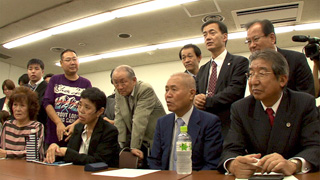Sennan Asbestos Disaster
(Nippon-koku vs Sennan ishiwata mura) JAPAN / 2017 / Japanese / Color / DCP / 215 min
JAPAN / 2017 / Japanese / Color / DCP / 215 min
Director, Photography: Hara Kazuo
Editing: Hata Takeshi
Sound Editor: Ogawa Takeshi
Music: Yanashita Mie
Producer: Kobayashi Sachiko
Post-production Producer: Shimano Chihiro
World Sales: Uzumasa Inc.
In the early twentieth century, Osaka’s Sennan district began to prosper thanks to the asbestos industry. Years later saw the appearance of diseases such as lung cancer and mesothelioma, caused by fibers that entered the lungs of former factory workers, their families and local residents. They file a lawsuit seeking compensation from the state for asbestos-related illnesses, and win their initial case in court. Nevertheless, the state pursues numerous appeals. As the legal proceedings drag on, one by one the plaintiffs pass away. In this, his first documentary feature in twenty-three years, Hara Kazuo lends his support to the cause of the plaintiffs and their legal team by painstakingly documenting their eight-year legal battle, right up to the Supreme Court. Skilled filmmaker Hara draws out for the camera the raw emotions of the victims and their families, faithfully representing the drama of this intense struggle right up until the final judgment.
[Director’s Statement] Naturally it has never been simple for me as a filmmaker to work out the subject of any particular film, or how to go about expressing it. That said, this time I found it singularly difficult. While I had no hesitation as to the object of my camera’s eye, I could not figure out the thrust of the work, or the message it would convey—even after eight years of bewildered shooting had finished. It took two years of editing trial and error for a structure to take shape and show its scale, and for me to finally set my eyes on the work as a whole. It was only then that I found myself conscious of the substance of what I had been seeking.
Documentaries depict the myriad emotions of people living in a certain time period, exposing what it means to live in that particular era. I see my work to date as being of the Showa era (1926–1989), “Showa documentaries” if you will, which must make this film, made in the Heisei era (1989-present), a “Heisei documentary.” But I never realized what a struggle it would be to get my head around what it was about the Hesei era that I thought should be depicted.
Japan’s democracy is currently in unprecedented crisis. I came into this world in 1945, in a shelter to which my mother had evacuated, during the large-scale air raids across mainland Japan. And I was raised under the democracy that was introduced after the war. Now, this democracy appears to be collapsing, as some of those holding the reins of power go on the rampage. It is precisely the nature of the age in which we live that means that makes us Japanese ask ourselves what we can do about such a situation. Hence this film is indeed a self-portrait of the Heisei Japanese people.
 Hara Kazuo
Hara KazuoBorn June 1945 in Ube City, Yamaguchi Prefecture. After dropping out of the Tokyo Technical School of Photography, Hara Kazuo began to work with disabled children while employed as an assistant of a school for the disabled and released the photography collection Bakani Sunna (Don’t Make Fun of Us). In 1972, he founded Shisso Productions with Kobayashi Sachiko. That same year, Hara had his directorial debut with Goodbye CP, a documentary film on “relationship revolution” bridging disabled and abled people. In 1974, he released Extreme Private Eros: Love Song 1974, a film documenting the unassisted childbirth of his ex-wife Takeda Miyuki, who had left Hara to move to Okinawa. The film received high praise as a pioneering work of self-documentary. In 1987, Hara released The Emperor’s Naked Army Marches On, which documents the former Japanese soldier Okuzaki Kenzo as he fervently pursues the war responsibilities of his superior officers. The film was a big hit, and was awarded the Directors Guild of Japan New Directors Award, the Berlinale Caligari Prize, and the Grand Prix at Cinéma du Réel, among other awards. In 1994, he released A Dedicated Life, in which he closes in on the truth and lies of novelist Inoue Mitsuharu. The film was ranked Number One on the Kinema Junpo Best Ten. In 2005, Hara released his first narrative film, The Many Faces of Chika, in which four actresses portray the life of a single person. He served as a juror at YIDFF ’93, and works towards nurturing new generations of documentary filmmakers. Though the works Hara has released are few in number, they have all been highly acclaimed, and retrospectives of his work have been held at international film festivals around the globe.
